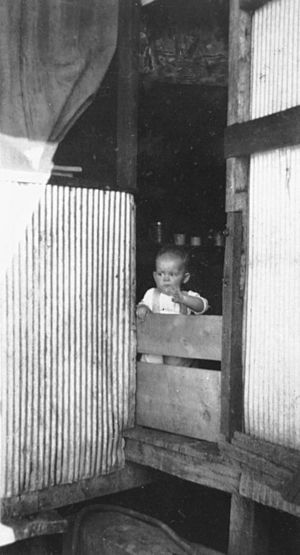Tent House, Mount Isa facts for kids
Quick facts for kids Tent House, Mount Isa |
|
|---|---|

Tent House, 2013
|
|
| Location | Fourth Street, Parkside, City of Mount Isa, Queensland, Australia |
| Design period | 1919 - 1930s (interwar period) |
| Built | c. 1930 |
| Official name: Tent House (Mount Isa) | |
| Type | state heritage (built) |
| Designated | 21 October 1992 |
| Reference no. | 600742 |
| Significant period | 1930s (fabric, historical) |
| Significant components | lawn/s, residential accommodation - workers' quarters |
| Lua error in Module:Location_map at line 420: attempt to index field 'wikibase' (a nil value). | |
The Tent House is a special old house in Mount Isa, Queensland, Australia. It was built around 1930. This unique house is listed on the Queensland Heritage Register, which means it's an important part of history that needs to be protected.
Contents
The Story of the Tent House
Why Mount Isa Needed Tent Houses
From 1926 to 1930, many people moved to Mount Isa very quickly. This sudden growth meant there weren't enough homes for everyone. Hundreds of people, especially railway and construction workers, lived in tents. Some even lived in huts made from old chemical drums and corrugated iron.
Building a New Town for Workers
To help with the housing problem, a mining company started building a new town just for its workers. This town was carefully planned. The company believed that taking good care of its employees was very important, especially in a tough climate and with past worker disagreements.
By mid-1929, the company had built about 50 small houses and 7 staff homes. They also added running water and modern toilets. They even built a large house with 21 bedrooms for staff. For single men, there were five dormitories, each for 40 men, and a big dining hall. Because so many people were arriving, they also built temporary places for 400 more men.
How Tents Became Tent Houses
Even with new buildings, housing was still a big problem. In 1934, the company noticed that about 60 tents, built in 1930, were in bad shape. Workers asked for help, and the company agreed to provide materials to turn these tents into "tent houses." The workers then helped each other build them.
To make a tent house, workers added a metal roof above the tent's fabric roof. They also added metal walls outside the tent's fabric walls. This created an air space between the metal and the fabric. This air space helped keep the house cooler during the hot summer months.
The Tent House Today
More workers came to Mount Isa in the late 1940s, and tents were used again. In the 1960s, much of the original company town was removed because it was on top of valuable copper ore.
The Tent House on Fourth Avenue was one of the last remaining tent houses in the city by 1967. People decided to keep it as a museum to remember the past. Today, the National Trust helps manage it.
In 2013, the Tent House was moved to the Underground Hospital site. This new location helps protect it better and makes it easier for visitors to see.
What the Tent House Looks Like
The Tent House is a simple building made of timber. It has a triangular, or gable, roof. On the eastern side, there's a verandah (a covered porch) that has been enclosed.
A second, higher timber frame roof, also with a gable shape, sits over the house. This outer roof shades the house, with about a 1-meter (3 feet) space between the two roofs. The inner house roof and its gable walls are covered with canvas. The other walls of the inner house are covered with "ripple iron," which is a type of corrugated metal.
The enclosed verandah and the outer tent roof are covered with corrugated iron. The sides of the house and verandah have glass louvre windows. These windows have slats that can be opened or closed to let air in. The building stands on a grassy area. In 1937, it was described as having three rooms, with walls of galvanized iron and a drum roof. The floor was made of boards and earth. The only other tent house in Mount Isa was taken down in 1991.
Why the Tent House is Important
The Tent House was added to the Queensland Heritage Register on 21 October 1992. It's important for a few reasons:
- A Rare Piece of History: The Tent House is one of the very few examples left of a type of home that was once common in Mount Isa during the 1930s. It shows how people lived when there weren't enough houses.
- A Link to the Community's Past: Even though it was built as a temporary home, the local community wanted to keep it. It helps them remember the early days of mining in Mount Isa and how people adapted to challenges.


